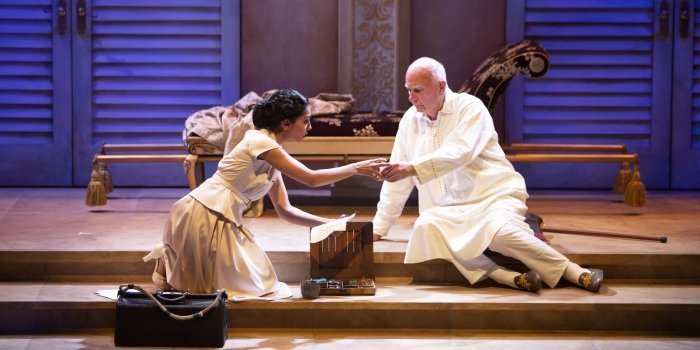In William Shakespeare’s original text of All’s Well That Ends Well, the lead protagonist Helena says,
“… Thus, Indian-like,
Religious in mine error, I adore
the sun, that looks upon his worshipper,
but knows of him no more.”
Working class Helena’s comment refers to her unrequited love for the aristocratic son of her guardian, the Countess of Rousillon, in France back in Shakespeare’s day. But the speech is irrelevant and has been cut in this summer’s Bard on the Beach production because Helena is Indian (East Indian that is).
Co-creators and directors Johnna Wright and Rohit Chokhani set the play in India during its last year of British rule and Partition in 1947, when the “Britishers” divided the mostly Muslim and Hindu population into what is now Pakistan in the north, and India in the south.
Wright’s and Chokhani’s rationale, to make the play relevant to modern audiences, succeeds brilliantly. It provides a vivid backdrop to the action and transforms All’s Well That Ends Well from a sexist, classist romp into a poignant piece of theatre.
That isn’t to say that it’s tedious and too worthy. Far from it. Jeff Gladstone as Parolles, a foolish follower of Bertram (the debonair object of Helena’s devotion) provides plenty of jovial slapstick humour. He and David Marr as Lafeu, in this instance interpreted as a mature padre army officer, play off each other with the perfect timing expected from such seasoned Bard on the Beach performers. Newcomers to the company, such as highly accomplished Lucia Frangione as the British Countess, and Edmund Stapleton as her son, perform equally well.
In fact, the only time when a slight hiatus inhibits enjoyment is when Bernard Cuffling’s British Viceroy lies mortally ill. Cuffling might have taken Method Acting a tad too far in this case. As a result of his being the character rather than portraying him, some lines are muddied to the extent that his dialogue gets hard to follow. However, after Helena applies the miraculous cure bequeathed by her eminent doctor father, Cuffling attacks his part with all the energy derived from new-found health. And all’s well.

Carmen Alatorre’s costume design is only marred when a soldier marches onstage after a quick change, with the straps of his rucksack unfastened and flapping. All 1940s soldiers would be outfitted impeccably, except for Parolles whose garb intentionally swings between untidy and outrageous.
But this production’s attention to detail in all respects other than those two mentioned is top notch. For instance, Pam Johnson’s set breathes the sultry heat of India into the lush colonial palaces of Delhi before intermission and the colourful markets of the Punjab afterwards. It’s beautiful.
The multi-faceted soundscape, designed by Ruby Singh, ranges from original music composed by him to the drone of airplanes carrying those “Britishers” and their chattels back to their own country. It immediately and effectively transports everyone to the time and place of the action.
Traditional singing and dancing, exchanges in Hindi and Punjabi, plus the rich aroma of Asian spices add to the evocative backdrop for this tale of true love tinged with intrigue, political turmoil, colonial exploitation, and foolish comedy.
Sarena Parmer threads it all together as Helena with grace and intelligence. She is abetted in her scheme to win the heart of Bertram by the exotic maiden Diana, played with saucy tongue-in-cheek by Pam Patel.
Enjoyment is coupled with enlightenment as Indians and Pakistanis carry signs, each protesting that many of their number are stranded in the other’s newly drawn territory. Their “British Go Home” sign still stands defiantly. The Union Jack is replaced by the flags of the two newly formed South Asian nations as Helena unravels her identity and India and Pakistan realize theirs. Such intense moments of drama and sentiment are popped by old Padre Lafeu as he wipes his tears, saying, “My eyes smell onions.” So do ours, as all ends wonderfully well … or does it?
All’s Well That Ends Well by William Shakespeare. Directed by Johnna Wright and Rohit Chokhani. A Bard on the Beach Shakespeare Festival production. Playing in repertory on the Howard Family Stage in the Douglas Campbell Theatre at Vanier Park with Coriolanus until September 11. Visit bardonthebeach.org for tickets and information.